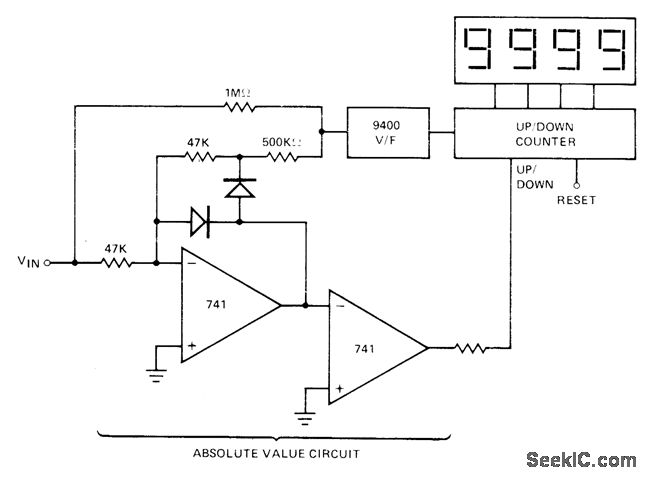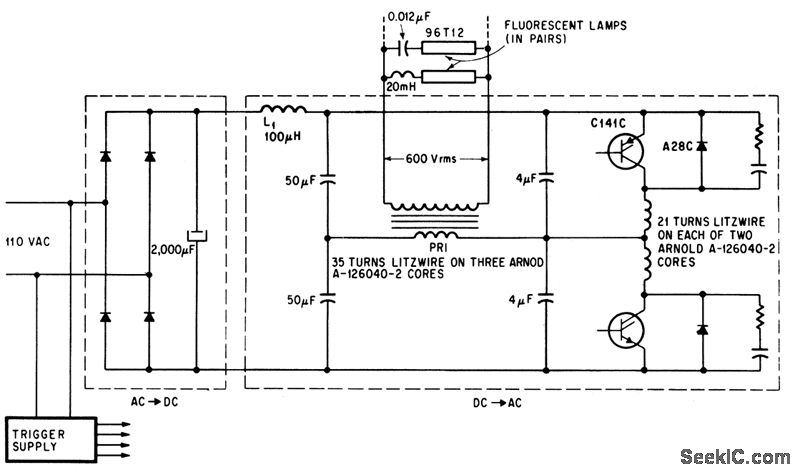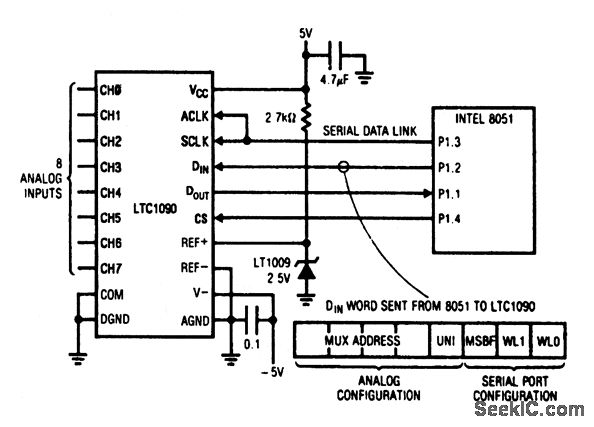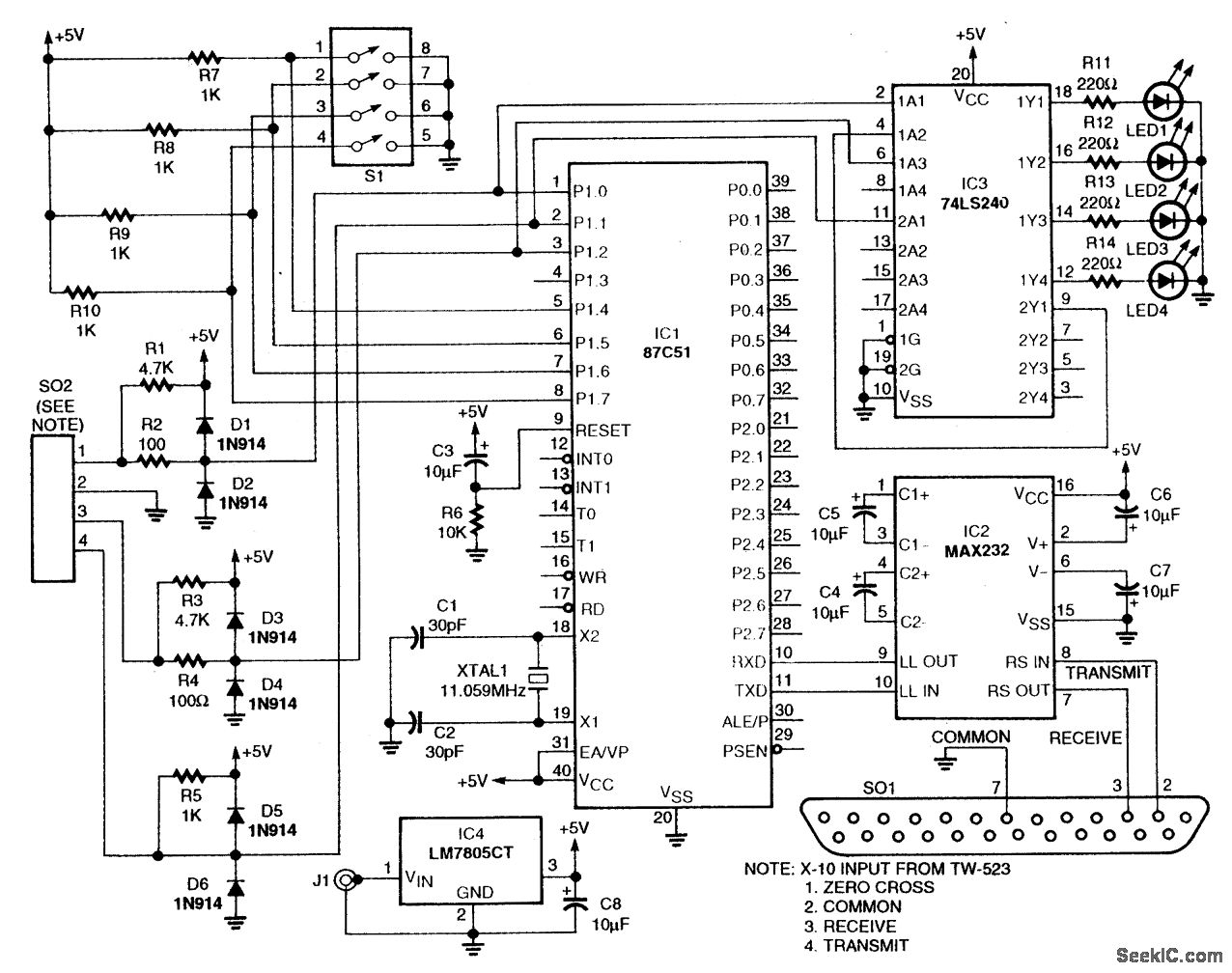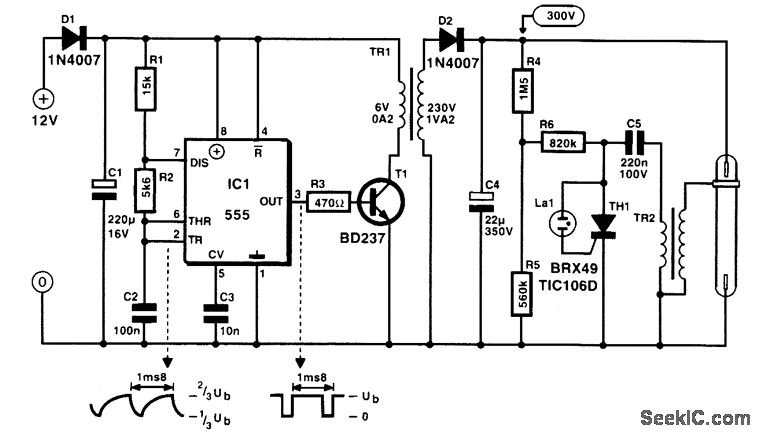
HC132 Selling Leads
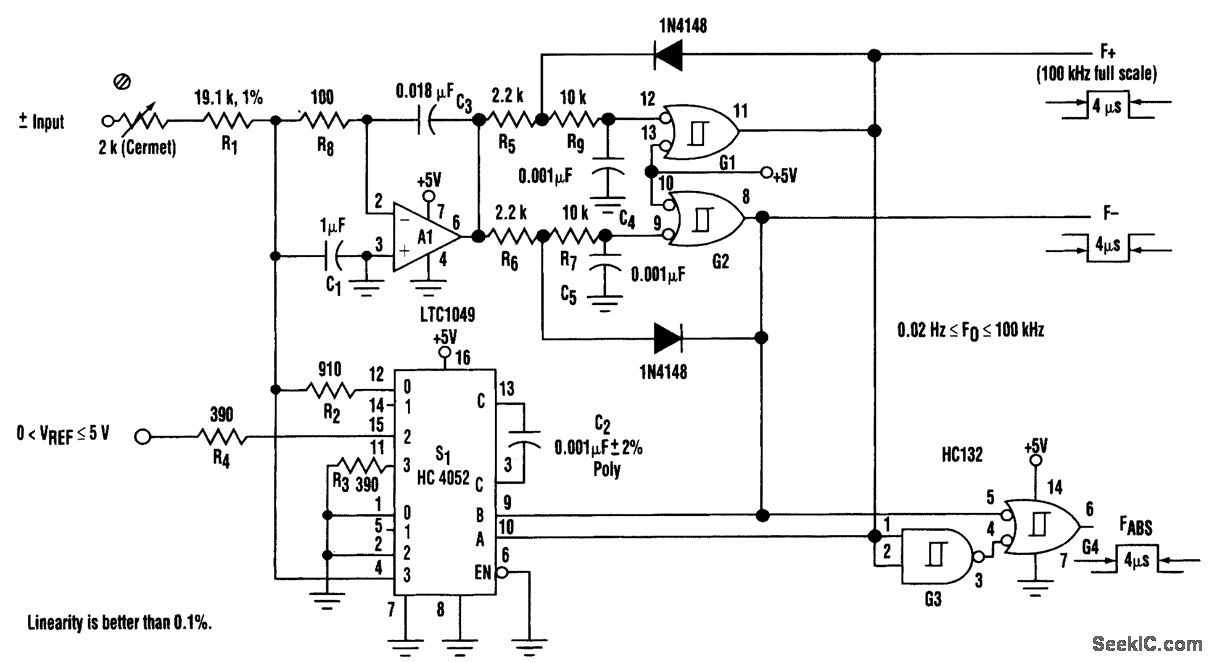
The circuit safeguards a solid-state relay from overload conditions. It limits current, automatically disconnects the load upon detecting a short circuit, and generates a fault-condition output signal. During normal operation, the controlling pulse train generator (ptP) sets the flip-flop, IC1, which activates transistor Q1. When Q1 is turned on, current flows through the input of the solid-state relay, thereby activating the relay. In the event of an overcurrent or fault condition, the excessive load current flowing through the relay generates sufficient voltage across the sense resistor R5 to activate one of the optoisolators, IC4A or IC4B. The output transistor of the optoisolator redirects current away from the input of the solid-state relay, limiting the current that the relay's output can deliver. If the overload is significant enough, the optoisolator raises the input of the Schmitt trigger above its threshold, which resets the flip-flop and deactivates the solid-state relay. Resistor R2 serves two purposes: it ensures that the input to the Schmitt trigger remains below 5 V to prevent latch-up and acts as part of an RC filter in conjunction with capacitor C1. This RC filter mitigates the risk of spurious triggering of the Schmitt trigger. The output from the flip-flop can be utilized to signal overload conditions to the controlling pulse train generator.
The described circuit functions as a protective mechanism for solid-state relays, primarily focusing on preventing damage due to overloads and short circuits. The operational sequence begins with the controlling pulse train generator (ptP), which initiates the flip-flop (IC1). The flip-flop's output controls transistor Q1, allowing current to flow through the relay's input, thus activating the relay to perform its intended function.
In the event of an overcurrent situation, the circuit is designed to detect excessive current through the sense resistor R5. When the current exceeds a predetermined threshold, it generates a voltage that activates one of the optoisolators (IC4A or IC4B). The optoisolator's output transistor effectively shunts the current away from the relay's input, limiting the amount of current that can pass through the relay's output. This action prevents potential damage to the relay and the connected load.
If the overload condition persists and the voltage across the sense resistor continues to rise, the optoisolator will trigger the Schmitt trigger, which is designed to provide a clean switching response. The Schmitt trigger's input is monitored closely, and once the voltage exceeds its threshold, it resets the flip-flop, which in turn deactivates the solid-state relay. This ensures that the load is disconnected during fault conditions, thereby protecting both the relay and the load.
Resistor R2 plays a critical role in maintaining the integrity of the circuit. It limits the voltage at the Schmitt trigger input to below 5 V, preventing latch-up conditions that could lead to erratic behavior. Additionally, in conjunction with capacitor C1, R2 forms an RC filter that smooths out any potential noise or voltage spikes, protecting the Schmitt trigger from false triggering events.
The output from the flip-flop can be utilized to communicate overload conditions back to the controlling pulse train generator, allowing for further action or monitoring. This circuit design integrates robust features that ensure reliable operation and protection of solid-state relays in various applications.The circuit protects a solid-state relay from overloads. The circuit limits current, automatically discon-nects the load after detecting a short circuit, and develops a fault-condition output signal. In normal operation, the controlling ptP sets the flip-flop, IC1, which turns on transistor Q1. When Q1 turns on, current flows through the solid-sta te relay`s input, thus activating the relay. If an overcurrent or fault condition occurs, the excessive load current flowing through the relay develops enough potential across sense resistor R5 to turn on one of the optoisolators, IC4A or IC4B. The optoisolator`s output transistor diverts current around the solid-state relay`s input, which limits the cur-rent that the relay`s output can pass.
If the overload is severe enough, the optoisolator pulls the input of the Schmitt trigger above its threshold, thus clearing the flip-flop and turning off the solid-state relay. R2 has two functions: It keeps the input of the Schmitt trigger below 5 V max. to prevent latchup, and it forms an RC filter in conjunction with C1. The RC filter prevents spurious triggering of the Schmitt trigger. You can use the output of the flip-flop to signal overload conditions to the controlling P. 🔗 External reference
The described circuit functions as a protective mechanism for solid-state relays, primarily focusing on preventing damage due to overloads and short circuits. The operational sequence begins with the controlling pulse train generator (ptP), which initiates the flip-flop (IC1). The flip-flop's output controls transistor Q1, allowing current to flow through the relay's input, thus activating the relay to perform its intended function.
In the event of an overcurrent situation, the circuit is designed to detect excessive current through the sense resistor R5. When the current exceeds a predetermined threshold, it generates a voltage that activates one of the optoisolators (IC4A or IC4B). The optoisolator's output transistor effectively shunts the current away from the relay's input, limiting the amount of current that can pass through the relay's output. This action prevents potential damage to the relay and the connected load.
If the overload condition persists and the voltage across the sense resistor continues to rise, the optoisolator will trigger the Schmitt trigger, which is designed to provide a clean switching response. The Schmitt trigger's input is monitored closely, and once the voltage exceeds its threshold, it resets the flip-flop, which in turn deactivates the solid-state relay. This ensures that the load is disconnected during fault conditions, thereby protecting both the relay and the load.
Resistor R2 plays a critical role in maintaining the integrity of the circuit. It limits the voltage at the Schmitt trigger input to below 5 V, preventing latch-up conditions that could lead to erratic behavior. Additionally, in conjunction with capacitor C1, R2 forms an RC filter that smooths out any potential noise or voltage spikes, protecting the Schmitt trigger from false triggering events.
The output from the flip-flop can be utilized to communicate overload conditions back to the controlling pulse train generator, allowing for further action or monitoring. This circuit design integrates robust features that ensure reliable operation and protection of solid-state relays in various applications.The circuit protects a solid-state relay from overloads. The circuit limits current, automatically discon-nects the load after detecting a short circuit, and develops a fault-condition output signal. In normal operation, the controlling ptP sets the flip-flop, IC1, which turns on transistor Q1. When Q1 turns on, current flows through the solid-sta te relay`s input, thus activating the relay. If an overcurrent or fault condition occurs, the excessive load current flowing through the relay develops enough potential across sense resistor R5 to turn on one of the optoisolators, IC4A or IC4B. The optoisolator`s output transistor diverts current around the solid-state relay`s input, which limits the cur-rent that the relay`s output can pass.
If the overload is severe enough, the optoisolator pulls the input of the Schmitt trigger above its threshold, thus clearing the flip-flop and turning off the solid-state relay. R2 has two functions: It keeps the input of the Schmitt trigger below 5 V max. to prevent latchup, and it forms an RC filter in conjunction with C1. The RC filter prevents spurious triggering of the Schmitt trigger. You can use the output of the flip-flop to signal overload conditions to the controlling P. 🔗 External reference
